The Society
Founded as "Medical Ozone Society" in 1972 and renamed since 1993 as "Medical Society for The Use of Ozone in Prevention and Therapy", the primary objective has been the coordination of basic aspects, to activate research and to lead ozone therapy to become a generally accepted part in medicine.
Ozone therapy today understands itself as a genuine method in complementary medicine, scientifically based, well documented and well published in peer reviewed journals.
Guidelines had been set up already in the early 1990s, first published in 1998 and now in an updated and revised edition in 2012 in „Ozone: Science and Engineering“, the scientific journal of theInternational Ozone Association IOA.In 2016 the clinical evaluation and evidence classification of Major Autohemotherapy
Guidelines had been set up already in the early 1990s, first published in 1998 and now in an updated and revised edition in 2012 in „Ozone: Science and Engineering“, the scientific journal of theInternational Ozone Association IOA.In 2016 the clinical evaluation and evidence classification of Major Autohemotherapy
and Rectal Insufflation has been filed and
accepted for publication, see under „Literature Service“.
Based on the pharmacological and biochemical research in the last 20 to 30 years the following indications have been established: Chronic inflammatory diseases and diseases accompanied by inflammation, such as Angiopathia, arterial circulators disorders, Rheumatoid arthritis, Pain management Chronic hepatitis and Complementary oncology (see library and video library). Medical ozone is always understood as part of a complementary concept to a basic therapy. Following the Guidelines of the low-dose ozone concept treatment strategies have been developed, offered as e-books and taught in seminars and videos.
Open video and book library
Based on the pharmacological and biochemical research in the last 20 to 30 years the following indications have been established: Chronic inflammatory diseases and diseases accompanied by inflammation, such as Angiopathia, arterial circulators disorders, Rheumatoid arthritis, Pain management Chronic hepatitis and Complementary oncology (see library and video library). Medical ozone is always understood as part of a complementary concept to a basic therapy. Following the Guidelines of the low-dose ozone concept treatment strategies have been developed, offered as e-books and taught in seminars and videos.
Open video and book library
Continue reading...
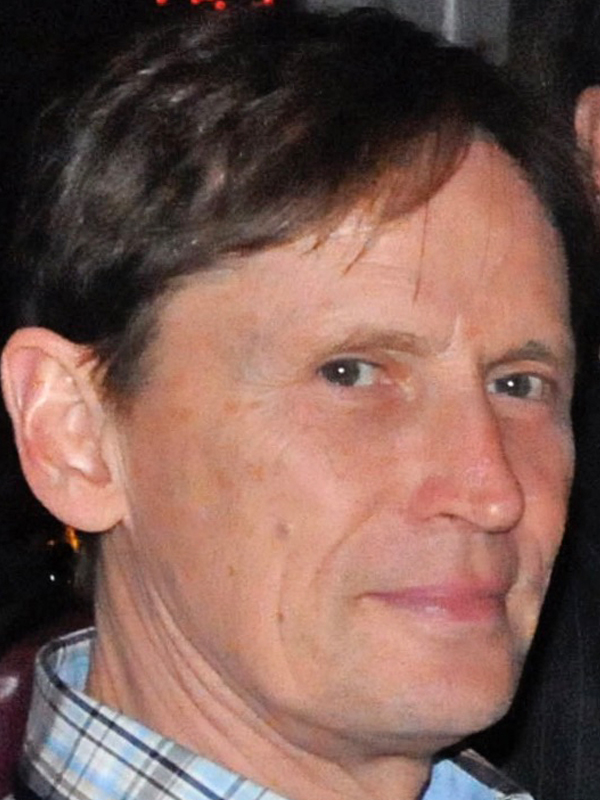

2. Vorsitzender
Dr. med. Philip Mavberg
langjähriger Chefarzt einer Reha Klinik und seit 2024 medizinischer Leiter des INUSpheresis Center,
Aeschengraben 10, CH 4051 Basel
mavberg@proton.me
Dr. med. Philip Mavberg
langjähriger Chefarzt einer Reha Klinik und seit 2024 medizinischer Leiter des INUSpheresis Center,
Aeschengraben 10, CH 4051 Basel
mavberg@proton.me
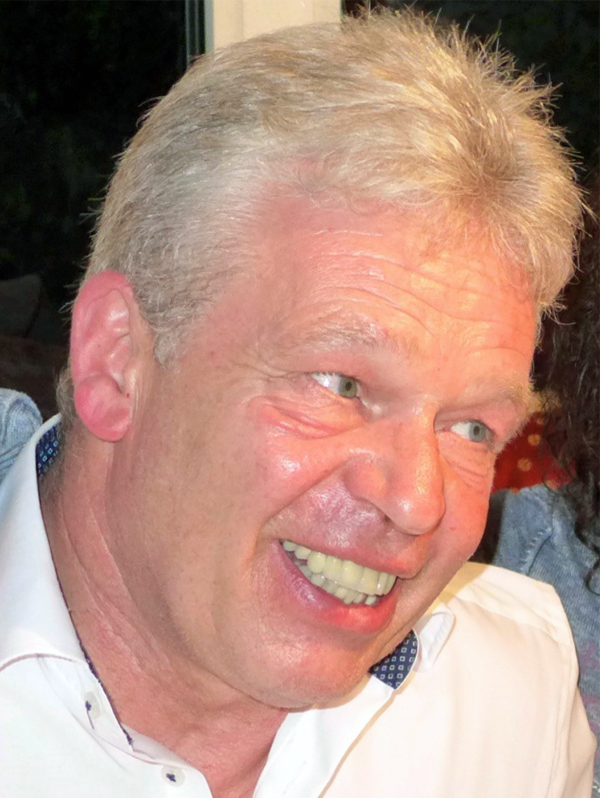
Schriftführer
Heinrich Habig
Staakener Straße 13
45699 Herten
Arzt für Naturheilverfahren und Schmerztherapie
info@ozongesellschaft.de
Heinrich Habig
Staakener Straße 13
45699 Herten
Arzt für Naturheilverfahren und Schmerztherapie
info@ozongesellschaft.de
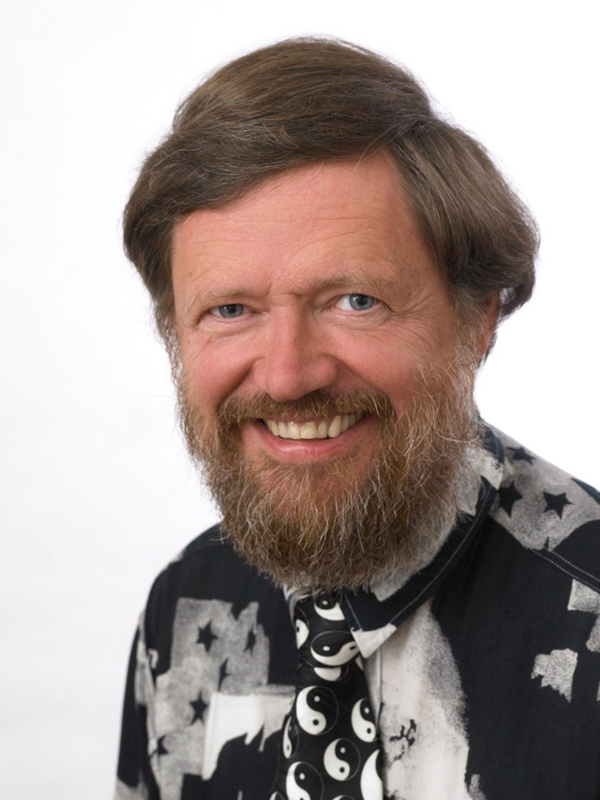
Kassenwart
Dr. med. Michael Schreiber
Frühlingsstraße 8
D-86482 Aystetten/Augsburg
Internist und Arzt für Naturheilverfahren
dr.michael.schreiber@gmx.de
Dr. med. Michael Schreiber
Frühlingsstraße 8
D-86482 Aystetten/Augsburg
Internist und Arzt für Naturheilverfahren
dr.michael.schreiber@gmx.de
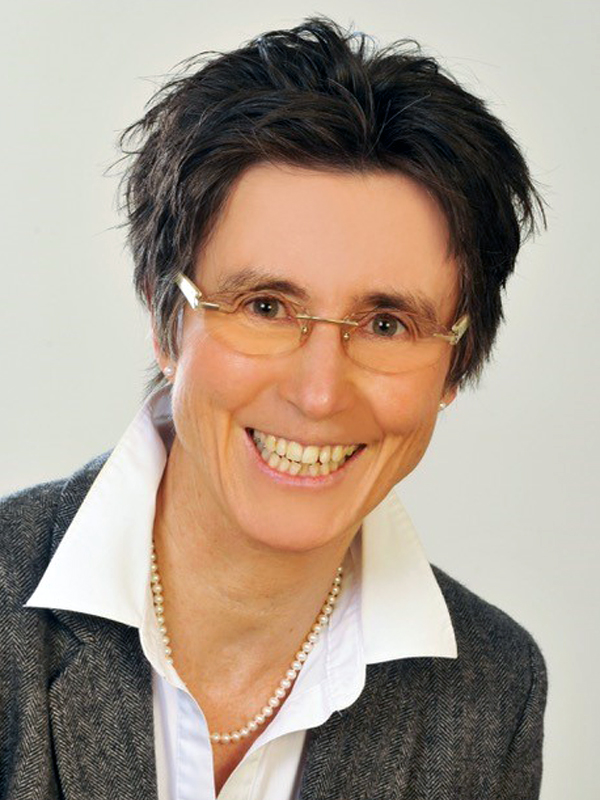
Beratendes Vorstandsmitglied
Dr. med. Monika Pirlet-Gottwald
Weisenhausstraße 52a
D-80637 München
Ärztin für Naturheilverfahren
Ernährungsmedizin
pirlet-gottwald@t-online.de
Dr. med. Monika Pirlet-Gottwald
Weisenhausstraße 52a
D-80637 München
Ärztin für Naturheilverfahren
Ernährungsmedizin
pirlet-gottwald@t-online.de

Beratende Vorstandsmitglied
Anna Mücke, M.SC. (AT)
INUSpheresis Center Basel
Aeschengraben 10
CH 4051 Basel
mavberg@proton.me
Anna Mücke, M.SC. (AT)
INUSpheresis Center Basel
Aeschengraben 10
CH 4051 Basel
mavberg@proton.me
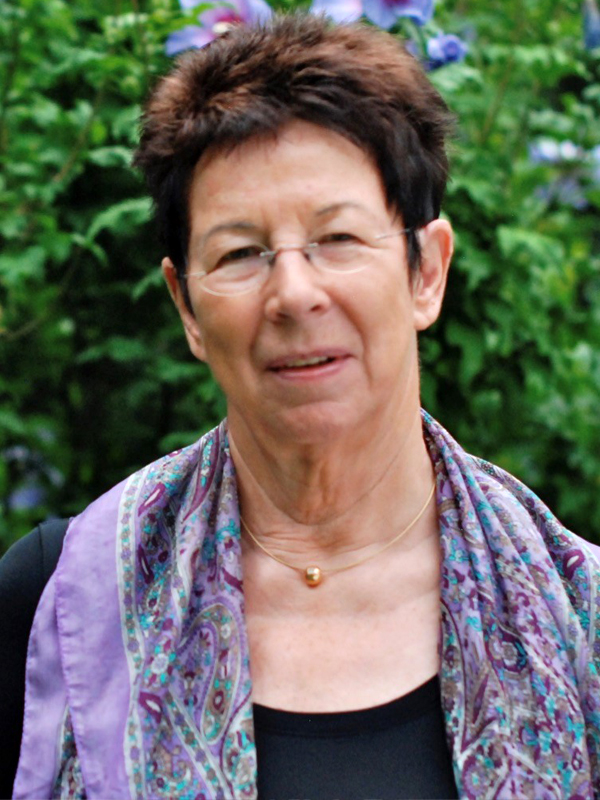
Beratendes Vorstandsmitglied
Dr.rer.nat. Renate Viebahn-Hänsler
Nordring 10
D-76473 Iffezheim/Baden-Baden
Biochemie/Pharmakologie
renate.viebahn
@ozongesellschaft.de
Dr.rer.nat. Renate Viebahn-Hänsler
Nordring 10
D-76473 Iffezheim/Baden-Baden
Biochemie/Pharmakologie
renate.viebahn
@ozongesellschaft.de
Why to become a member?
You will have free access to literature and all the information: all the books, e- books, videos will be free of charge for members of our society. For most of the seminars and workshops you will have free access,
You will have free access to literature and all the information: all the books, e- books, videos will be free of charge for members of our society. For most of the seminars and workshops you will have free access,
for international congresses of the European Cooperation or International Ozone Association reduced admission.
Please apply for membership - download PDF
Please apply for membership - download PDF

European Ozone Congress, Charité Berlin, 2017
The “International Ozone Association” (IOA) was founded in 1971 as “International Ozone Institute” (IOI), a kind of holding organization for all ozone fields and applications in industry and technology.
The IOA gathers over 1,000 scientific and technical members.
Beyond the biennal World Congresses, the IOA has its own scientific journal since 1979: “Ozone:Science & Engineering” covering environmental and human health protection, such as water, air, soil, waste purification; Medical therapy and facility safety.
The medical field has been integrated into the European group EA3G managing the IOA membership of Europe,
Africa, Asia and Australasia:
www.ioa-ea3g.org
For medical requirements, the first society has been founded in Germany in 1972: The Medical Society for Ozone Application in Prevention and Therapy (Ärztliche Gesellschaft für Ozon-Anwendung in Prävention und Therapie): www.ozone-association.com or www.ozongesellschaft.de
www.ioa-ea3g.org
For medical requirements, the first society has been founded in Germany in 1972: The Medical Society for Ozone Application in Prevention and Therapy (Ärztliche Gesellschaft für Ozon-Anwendung in Prävention und Therapie): www.ozone-association.com or www.ozongesellschaft.de
To make the use of medical ozone more effective by providing a larger platform, a group of European societies
dedicated to its application of medical ozone have decided to join hands in closer cooperation, thus founding
the European Cooperation as a central organisation in 2001.
To standardize ozone therapy to the greatest possible extent has mostly been done and published as Guidelines
in 2012.
In the same way, the member societies will aim at providing mutually valid training & development guidelines,
making provisions to the fullest possible extent for all indications and application methods of ozone therapy.
In the long run, a European or International Standard Qualification could become a uniform objective. The
European Cooperation group is not considered to be a society of its own, its board will merely consist of the
board members of all member societies together. The structure, objectives and fields of activity of each national
society will remain exactly as before.
Every 2nd or 3rd year a European Medical Ozone - Congress, with seminars and workshops, is done, all held in English language. One of the national societies in turn will be responsible for the organization.
Every 2nd or 3rd year a European Medical Ozone - Congress, with seminars and workshops, is done, all held in English language. One of the national societies in turn will be responsible for the organization.
You will find the currently held training sessions, courses, seminars and congresses under the heading „Seminars, Workshops, Congresses” on
www.ozone-association.com.
Every member society is accessible under its own website, which provides information on the organisation and its board, as well as objectives and plans, in addition to other sources of information on the application of medical ozone.
Most of the presentations at the Congresses of the EUROCOOP are available:
1. First European Congress in Munich 2003
2. Cairo, Egyptian Congress 2006
3. Istanbul 2006
4. Baden-Baden 2008
5. Vienna 2010
6. Zürich 2014
7. Berlin 2017
8. Nice 2019
Please place your order: info@ozongesellschaft.de (office)
or see contacts
Most of the presentations at the Congresses of the EUROCOOP are available:
1. First European Congress in Munich 2003
2. Cairo, Egyptian Congress 2006
3. Istanbul 2006
4. Baden-Baden 2008
5. Vienna 2010
6. Zürich 2014
7. Berlin 2017
8. Nice 2019
Please place your order: info@ozongesellschaft.de (office)
or see contacts
At present (2021), the following 11 Ozone Societies are members of the EUROCOOP:
Continue reading...
Switzerland
„Schweizerische Ärztegesellschaft für Ozon- und Sauerstofftherapien“ SAGOS, https://sagos.info/sagos
Germany
„Ärztliche Gesellschaft für Ozonanwendung in Prävention und Therapie“ www.ozongesellschaft.de
Egypt
“Egyptian Ozone Association” starting with the first congress in Cairo in February 2006: drtanbouli@gmail.com
Turkey
Turkish MODER Ozone Association has organized its 1st International Medical Ozone Congress in Istanbul in June 2006.
Japan
“Japanese Research Association for Medical and Hygienic Use of Ozone” JRAMHUO, e-mail: nakamuro@pharm.setsunan.ac.jp
Indonesien
The “Indonesian Medical Society for Ozone Therapy” e-mail contact (office): sseminau@pacific.net.id
„Schweizerische Ärztegesellschaft für Ozon- und Sauerstofftherapien“ SAGOS, https://sagos.info/sagos
Germany
„Ärztliche Gesellschaft für Ozonanwendung in Prävention und Therapie“ www.ozongesellschaft.de
Egypt
“Egyptian Ozone Association” starting with the first congress in Cairo in February 2006: drtanbouli@gmail.com
Turkey
Turkish MODER Ozone Association has organized its 1st International Medical Ozone Congress in Istanbul in June 2006.
Japan
“Japanese Research Association for Medical and Hygienic Use of Ozone” JRAMHUO, e-mail: nakamuro@pharm.setsunan.ac.jp
Indonesien
The “Indonesian Medical Society for Ozone Therapy” e-mail contact (office): sseminau@pacific.net.id
Spain
The Spanish Society: SEOT ”Sociedad Española de Ozonoterapia” www.seot.es
Spain
The Spanisch Society: ACEOOT „Asociación Científica Espanola de Aplicación de Oxígeno-Ozono Terapia“ www.aceoot.org
Romania
Societatea Stiintifica Romana de Oxigen - Ozono - Terapie ( S.S.R.O.O.T.) www.asociatia-ozonoterapie.ro
Austria
The Austrian Association for Ozone Therapy ÖGO (Österreichische Gesellschaft Ozontherapie ÖGO) www.ozon-sauerstoff.at
Argentina
Associacion Medica Argentina De Oxygeno Ozonoterapia (AMAOO) http://aaooac.org.ar
The Spanish Society: SEOT ”Sociedad Española de Ozonoterapia” www.seot.es
Spain
The Spanisch Society: ACEOOT „Asociación Científica Espanola de Aplicación de Oxígeno-Ozono Terapia“ www.aceoot.org
Romania
Societatea Stiintifica Romana de Oxigen - Ozono - Terapie ( S.S.R.O.O.T.) www.asociatia-ozonoterapie.ro
Austria
The Austrian Association for Ozone Therapy ÖGO (Österreichische Gesellschaft Ozontherapie ÖGO) www.ozon-sauerstoff.at
Argentina
Associacion Medica Argentina De Oxygeno Ozonoterapia (AMAOO) http://aaooac.org.ar
Activities
Over the year 20 – 30 regional seminars and workshops are provided for doctors and nurses following the
International Guidelines for the use of ozone in medicine listed under “Seminars”.
If not possible as face-to-face seminars we will provide online events. Dedicated to the main indications, applications and pharmacology, the societies offer half a day, full day and 3-days workshops as post doc education, mostly certified by the regional medical chambers with 3 up to 20 credits and the certificates of the medical ozone society concerned, see certificate of the European Congress in Berlin 2017. In the case of online seminars please take an email address which will be frequently used as the communication and invitations are only sent by emails.
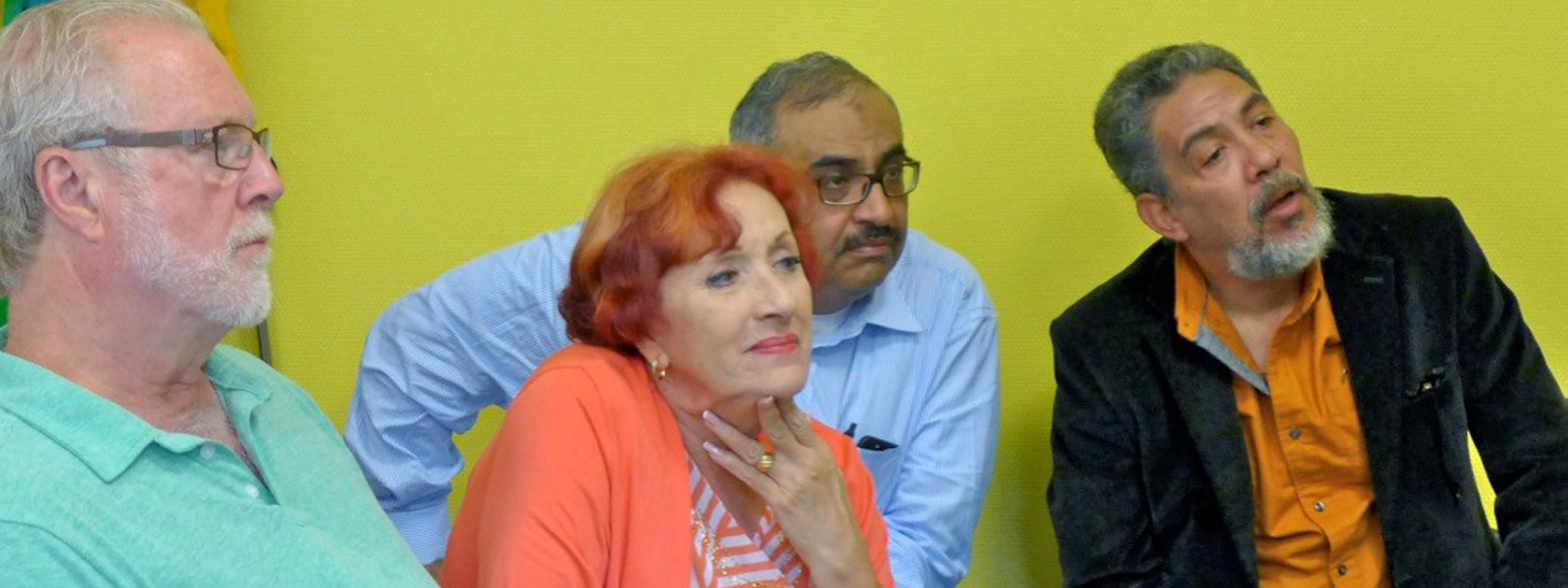
Our workshops are so exciting ...…
3-day workshop in rheumatology and pain therapy in Bad Kreuznach 2018
If you like to attend one of our seminars or congresses please contact
renate.viebahn@ozongesellschaft.de
info@ozongesellschaft.de (Office)
If not possible as face-to-face seminars we will provide online events. Dedicated to the main indications, applications and pharmacology, the societies offer half a day, full day and 3-days workshops as post doc education, mostly certified by the regional medical chambers with 3 up to 20 credits and the certificates of the medical ozone society concerned, see certificate of the European Congress in Berlin 2017. In the case of online seminars please take an email address which will be frequently used as the communication and invitations are only sent by emails.

Our workshops are so exciting ...…
3-day workshop in rheumatology and pain therapy in Bad Kreuznach 2018
If you like to attend one of our seminars or congresses please contact
renate.viebahn@ozongesellschaft.de
info@ozongesellschaft.de (Office)
For members of our society most of the seminars are free of charge.
Congresses + Seminars
The program and all lectures are now available as PDF-downloads
01 - Program
02 - Viebahn. Low-dose ozone concept...
03 - Chaijadi. Covid 19 prevention+treatment
04 - Tricarico. Long Covid 19
05 - Leon. Pharmacology of Ozone in Elderly
06 - Malatesta. Cell proliferation and death
07 - Navruzova. Gynaecology
08 - Navruzova. Purulent surgery
09 - Tanbouli. Fibromyalgia
10 - Bonetti. Chronic Back Pain
11 - Fahmy. Rheumatoid arthritis.
12 - Travagli, Tricarico. Safety. legislation.
13 - De Monte. Optimal blood ozonisation
14 - Umair Rashid. Disc lesions in diabetic patients
15 - Tabaracci. Local injections small and large joints
16 - Workshop Schueler. Holistic dentistry
17 - Workshop Schreiber Workshop Medical Ozone
Congresses + Seminars
Milan 2023
26th Ozone World Congress Milan July 2023The program and all lectures are now available as PDF-downloads
01 - Program
02 - Viebahn. Low-dose ozone concept...
03 - Chaijadi. Covid 19 prevention+treatment
04 - Tricarico. Long Covid 19
05 - Leon. Pharmacology of Ozone in Elderly
06 - Malatesta. Cell proliferation and death
07 - Navruzova. Gynaecology
08 - Navruzova. Purulent surgery
09 - Tanbouli. Fibromyalgia
10 - Bonetti. Chronic Back Pain
11 - Fahmy. Rheumatoid arthritis.
12 - Travagli, Tricarico. Safety. legislation.
13 - De Monte. Optimal blood ozonisation
14 - Umair Rashid. Disc lesions in diabetic patients
15 - Tabaracci. Local injections small and large joints
16 - Workshop Schueler. Holistic dentistry
17 - Workshop Schreiber Workshop Medical Ozone
Milan 2023
Certificate:
European Ozone Congress 2017, Charité Berlin
Continue reading...
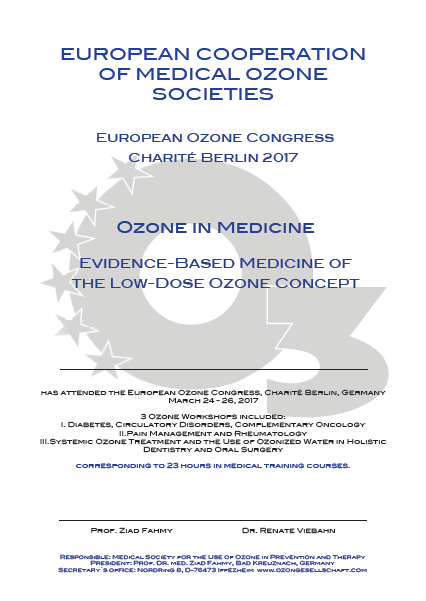
Certificate:
European Ozone Congress 2017,
Charité Berlin
with the special subject:
Evidence-based Medicine of the Low-dose ozone concept
The CURRICULUM “MEDICAL OZONE” follows the International Guidelines and is regularly adapted to the new results of clinical and preclinical research.
Charité Berlin
with the special subject:
Evidence-based Medicine of the Low-dose ozone concept
The CURRICULUM “MEDICAL OZONE” follows the International Guidelines and is regularly adapted to the new results of clinical and preclinical research.
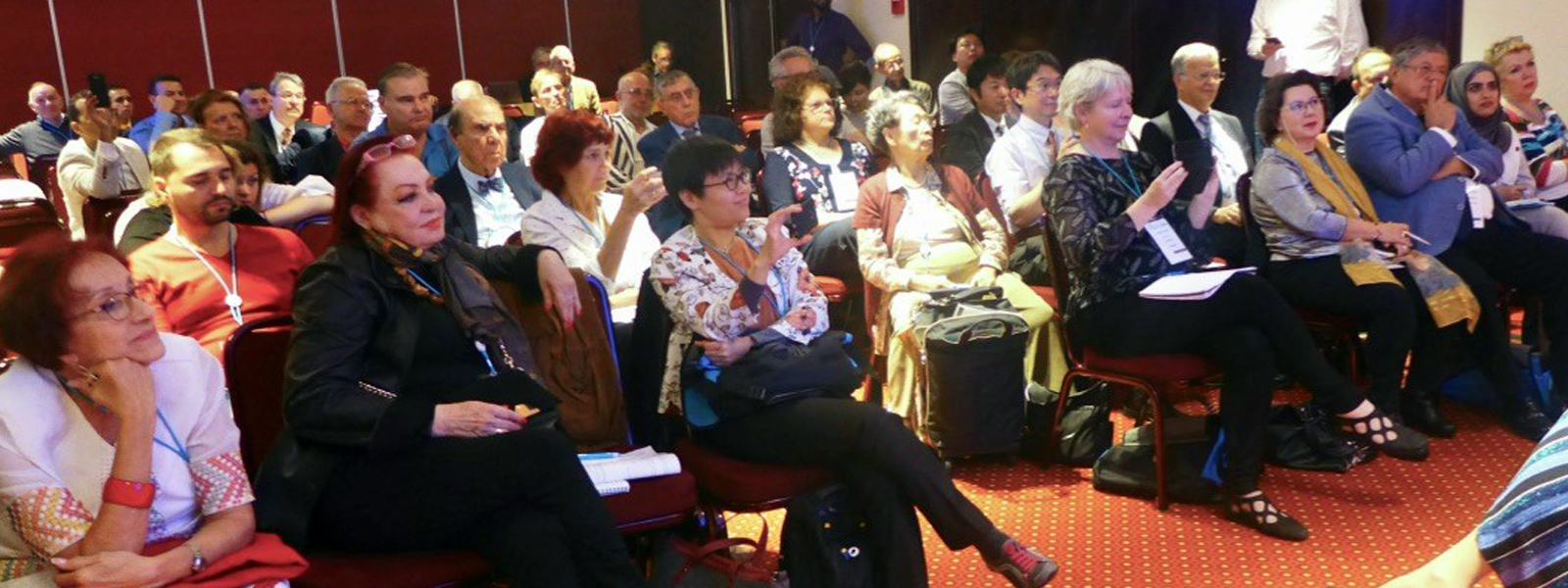
Medical ozone workshop at the 24th Ozone World Congress of the IOA in Nice 2019"
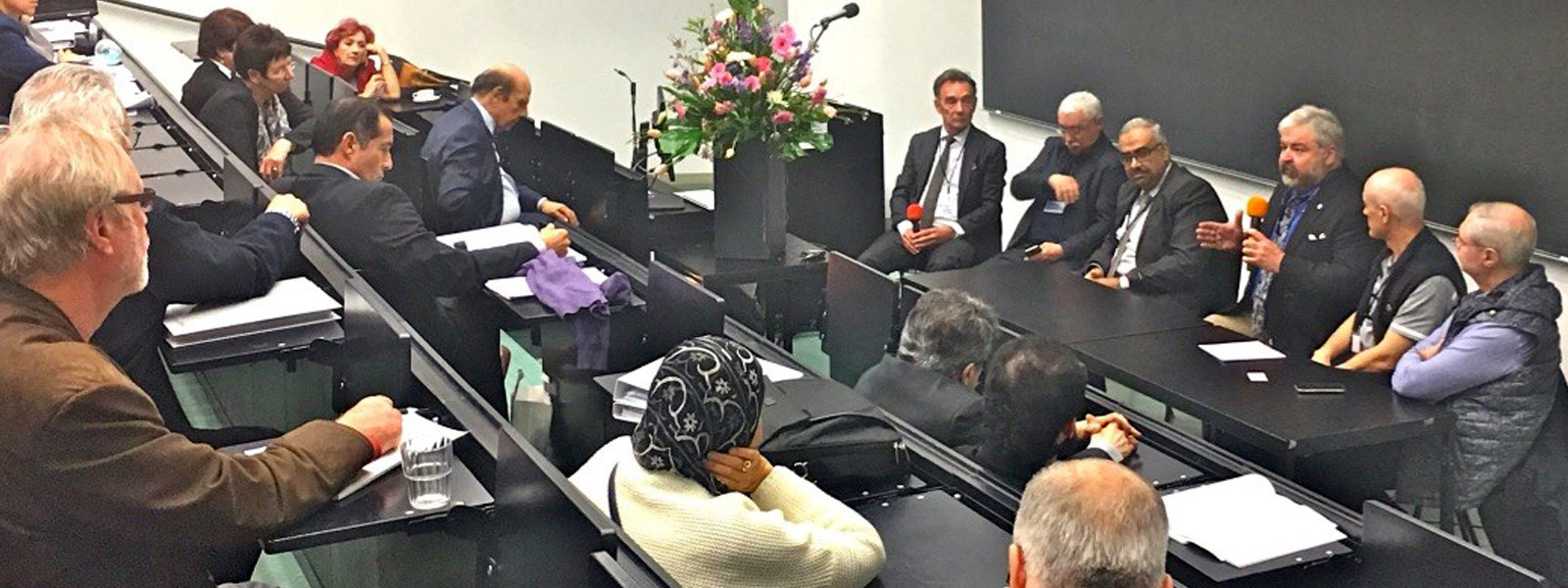
European Ozone Congress, Charité Berlin, 2017
Video and book library
To provide a better access to our seminars and lectures for english speaking doctors and
countries we have set up a video library where we will start with six lectures in
English covering the basic knowledge of ozone therapy as well as providing treatment concepts.
And
…you will have the book to our movie in 3 languages.
English covering the basic knowledge of ozone therapy as well as providing treatment concepts.
And…
you will have the book to our movie in 3 languages.
Link to our books / Link to our videos
you will have the book to our movie in 3 languages.
Link to our books / Link to our videos
Therapy
The effects of Medical Ozone as hormetic substance can be assigned to those defined by hormesis (Rattan et al. 2009): In living organisms,
single or repetitive administration of otherwise potentially dangerous or toxic substances in small doses increases their homeodynamics
(homeodynamic space), ie their self-regulatory capacity. Or, alternatively: Moderate oxidative stress stimulates the protective mechanisms
of cells and organs and is biologically useful.
Long-term ozone inhalation (e.g. for 8 hours and using ozone concentrations up to 1 ppm in animal studies) produces oxidative distress,
with a corresponding increase in the formation of reactive oxygen compounds, lipoperoxides, cytokines, increasing infiltration of neutrophils
and activated macrophages inducing and maintaining inflammatory processes.
Biological response in the form of superoxide and OH radicals finally ends in a chronic inflammatory process
with disfunction and downregulation of the cellular anti-oxidants.
Therapeutic usefulness is obtained via specific and well experienced forms of application, whereby airways are a taboo in ozone therapy. Single doses at low concentrations produce positive oxidative stress, ie equivalent to a single dose of „ozone peroxides“, which result in a short-term effect on red and white blood cells involving induction of cell metabolism and bioregulation of enzymatic anti-oxidants
Therapeutic usefulness is obtained via specific and well experienced forms of application, whereby airways are a taboo in ozone therapy. Single doses at low concentrations produce positive oxidative stress, ie equivalent to a single dose of „ozone peroxides“, which result in a short-term effect on red and white blood cells involving induction of cell metabolism and bioregulation of enzymatic anti-oxidants
Continue reading...
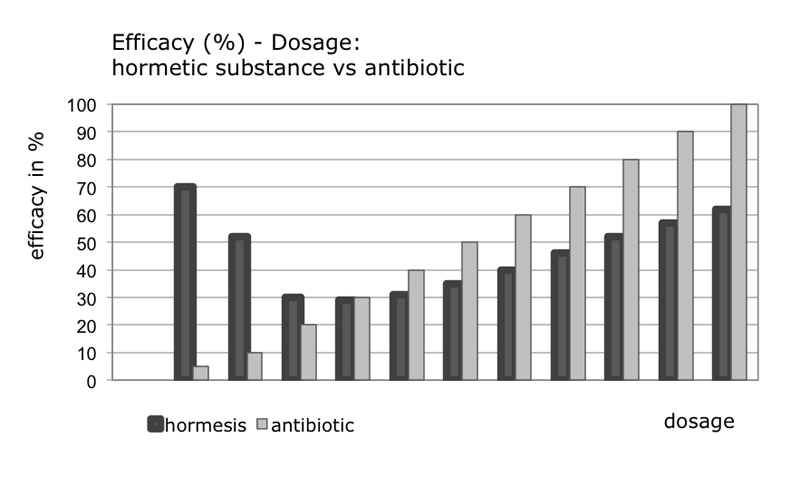
The ozone efficacy follows the principle of hormesis: low concentrations
and dosis of a substance, here ozone -which is otherwise toxic- are biologically
effective; displayed schematically by the efficacy-dosis graph compared to
antibiotics.
| TOXICITY OF OZONE IN THE RESPIRATORY SYSTEM VIA INHALATION | THERAPEUTIC EFFECT IN THE SPECIFIC FORMS OF MEDICAL OZONE APPLICATION |
| Long term exposure 8h etc. with ozone contrations up to 1 ppm* in animals |
Single dose Low concentration, low dose |
| Oxidative DYS-stress | Oxidative EU-stress = positive stress |
|
ROS (reactive oxygen species), LOP (lipid oxidation products), cytokines Increasing infiltration of neutrophils, Activation of macrophages |
|
|
Chronic inflammation
Superoxide and OH-radicals..... Disfunction of anti-oxidants |
Induction of cell metabolism |
| Downregulation of anti-oxidants | Regulation of anti-oxidants |
Medical ozone, an ozone/oxygen mixture consisting of purest O2 and maximum purity O3, is produced from medical oxygen
(in accordance with pharmaceutical legislation) using a medical ozone generator (Medical Devices Directives: 92/43 EEC or equivalent directives
in non European countries) in a concentration range between1 and 100 µg/ml (1 µg/ml = 1 mg/l = 1 g/m3).
Systemically, and specific to each application,
indication and patient, ozone concentrations between 10 and 30 µg/ml,
max. 40 µg/ml are administered corresponding to dosages of 500 to 2,000 µg per treatment. Topically 1 to 10 µg/ml is the preferred range
for small volume-injections e.g. in pain, 70 to 100 µg/ ml for disinfection and wound cleansing, 10 to 30 µg/ ml for wound healing.
Due to its metastable character, ozone always has to be produced on site of the use and has to be measured in real time.
When used in specific diseases and conditions, medical ozone produces the same or similar therapy results worldwide.
Improper application in the form of erratic methods and doses is the most frequent cause of ineffectiveness and adverse effects -
and always the cause of violent controversies.
For this reason, the medical societies for ozone application have set up treatment protocols as
basis for
standards and guidelines,
revised and published as a result of the most recent research and 30 years of experience (Beck at al 1998; Knoch et al 2009;
Viebahn et al 2012). They have been used in the standardization of applications, indications, concentrations, doses and
frequency of treatment as based on the mechanism of action and the pharmacology of ozone.
Low-Dose Concept
In its pharmacological effect, medical ozone follows the principle of hormesis: low concentrations (or doses)
show a high efficacy, which decreases with increasing concentration, finally reversing into a questionable
and even toxic effect. The Figure below shows the effect/concentration relationship for the systemic application
of ozone - in the form of a standardized major ozone autohemotherapy and rectal ozone gas insufflation – in
schematic form: Concentrations of 10 – 40 µg ozone / ml ozone/oxygen mixture represent those levels
which are physiologically effective and recommended for systemic application.
In the high concentration range of 60 -100 µg/ml the antibiotic effect of ozone has a wide range of
applications in the treatment of infected wounds, diabetic foot, decubitus ulcers and burns, but it is
completely restricted to the topical forms of application. Principally, ozone is applied complementary to a corresponding basic therapy.
Diabetes, Type 2 diabetes, chronic inflammatory diseases such as inflammatory vascular disease, in particualr
diabetic angiopathia, chronic hepatitis forms and chronic intestinal conditions
belong to the classic indications
within the low-dose ozone concept.
Chronic oxidative stress (pathologically increased values for malone dialdehyde MDA, hydrogen peroxide H2O2, total
hydroperoxide TH etc.) and an antioxidant deficit (disbalanced superoxide dismutase and subgroups of SOD as well as
catalase CAT and others) are phenomena common to all the above diseases. It is here in particular that low-dose
ozone as a hormetic substance, shows a regulatory effect on pathological processes.
Over the last 20 years the low dose ozone concept has developed into an established treatment method on a
sound scientific basis. Its biochemical action and pharmacological properties have been well investigated,
documented and published in internationally recognized journals in the context of its classical indications.
However, application techniques and doses still vary to a certain extent; these required recognized
international standardization to establish the optimum forms of ozone application and the most effective
concentration range in the relevant indications.
*Renate Viebahn-Hänsler, Olga Sonia León Fernández, Ziad Fahmy „Ozone in medicine: The low-dose ozone concept. Guidelines and treatment strategies“ Ozone Sci Eng 34, 408-424 (2)
Link - Taylor & Francis Online
Continue reading...
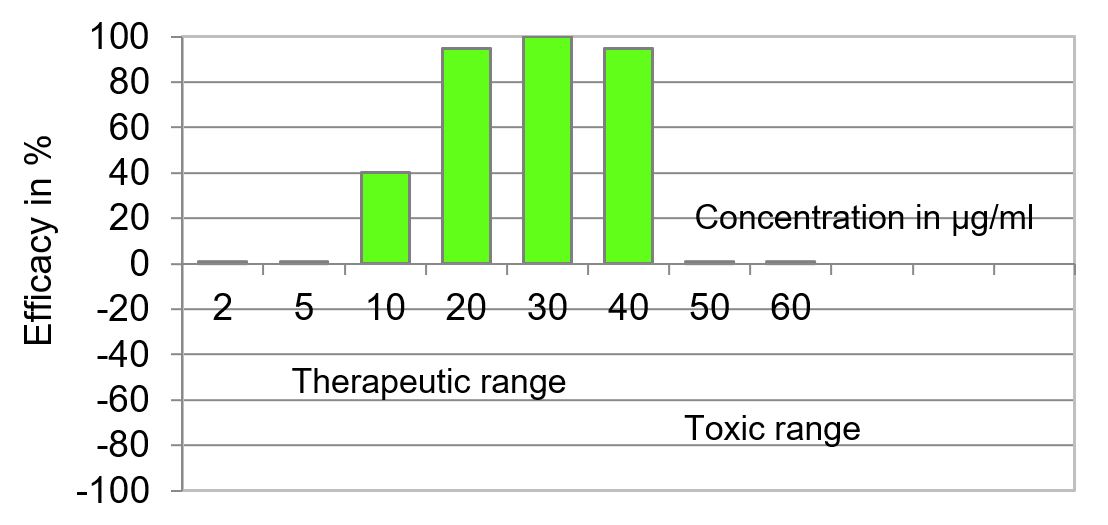
The low-dose ozone concept:
Efficacy/concentration relationship of systemically administered medical ozone. Low concentrations up to around 40 µg/ml show high efficacy, higher concentrations have no or toxic effects (hormesis). Ozone concentrations 70 to 90 or 100 µg/ml should never be used in systemic ozone therapy, the glutathione balance GSH/GSSG and the associated signal transduction are disturbed. With its germicidal effect the high ozone concentrations 70 to 100 µg/ml are effectively administered in highly infected wounds for disinfection and wound cleansing; for wound healing only 10 to 30 µg/ml (max. 40) are the concentrations of choice.
Efficacy/concentration relationship of systemically administered medical ozone. Low concentrations up to around 40 µg/ml show high efficacy, higher concentrations have no or toxic effects (hormesis). Ozone concentrations 70 to 90 or 100 µg/ml should never be used in systemic ozone therapy, the glutathione balance GSH/GSSG and the associated signal transduction are disturbed. With its germicidal effect the high ozone concentrations 70 to 100 µg/ml are effectively administered in highly infected wounds for disinfection and wound cleansing; for wound healing only 10 to 30 µg/ml (max. 40) are the concentrations of choice.
Ozone in Medicine. Clinical evaluation and evidence classification of the systemic ozone applications, Major Autohemotherapy and Rectal
Insufflation, according to the Requirements for Evidence-Based Medicine*
Abstract
Now that indications are clearly defined, applications have mostly become standardized and the active mechanisms have been well confirmed, medical ozone application in the form of the low-dose concept, is established and proven as a complementary medical method in the treatment of chronic inflammations or diseases associated with chronic inflammatory conditions. More than 11,000 systemic ozone treatments in the form of Major Ozone Autohemotherapy (MAH) in 577 patients and ≥ 47,000 Rectal Insufflations (RI) in 716 patients in various
Abstract
Now that indications are clearly defined, applications have mostly become standardized and the active mechanisms have been well confirmed, medical ozone application in the form of the low-dose concept, is established and proven as a complementary medical method in the treatment of chronic inflammations or diseases associated with chronic inflammatory conditions. More than 11,000 systemic ozone treatments in the form of Major Ozone Autohemotherapy (MAH) in 577 patients and ≥ 47,000 Rectal Insufflations (RI) in 716 patients in various
clinical studies are subjected to critical clinical assessment and
classification according to the criteria of evidence-based medicine (EBM).
Statistically significant clinical and/or pharmacological improvements without side-effects or adverse reactions are found in all
studies; special attention is drawn to maintaining hygiene when working with blood and to the use of ozone-resistent and biocompatible
materials. On summarizing the evidence classification under RCT + CT (Randomized Controlled Trials + Controlled Trials), i.e.
Levels Ib and IIa, 12 studies with 657 ozone-treated patients are obtained for MAH and 6 studies with 227 patients for RI. As a
result of the evidence here assessed, the two systemic ozone applications, MAH and RI are part of evidence-based medicine.
Both applications are effective, safe and economic.
Renate Viebahn-Hänsler , Olga Sonia León Fernández & Ziad Fahmy „Ozone in Medicine: Clinical Evaluation and Evidence Classification of the Systemic Ozone Applications, Major Autohemotherapy and Rectal Insufflation, According to the Requirements for Evidence-Based Medicine“ Ozone: Sci. Eng. July 2016
Link - Taylor & Francis Online
As based on the specific effects of ozone, we find the indications listed in the following Table 7.
Continue reading...
| Indications | Underlying effect |
| External ulcers and skin lesions Diabetic gangrene | • desinfection • wound cleansing • improved wound healing |
| Arterial circulatory disturbances, Angiopathia |
• activation of red blood cell metabolism with improved ..oxygen release • activation of enzymatic antioxidants and radical ..scavengers |
| Immune deficiency und immune dysbalance,
Chronic hepatitis (B and C), Complementary oncology, Supportive therapy for rheumatoid arthritis |
• activation of immunocompetent cells and release of
..cytokines such as interferones and interleukins. ..Modulation of the immune system • increase in antioxidant capacity through activation of ..the cellular antioxidants |
| Chronic/inflammatory diseases,
Colitis, proctitis, Gonarthrosis Activated arthrosis, Rheumatoid arthritis |
• antiinflammatory effect • activation of antioxidant enzymes and radical scavengers • activation of immunocompetent cells and cartilage cells ..eg with release of TGF-beta |
| Chronic pain, myofascial painsyndrome, Triggerpoints, fibromyalgia |
• antiinflammatory effect • activation of antioxidant enzymes and radical scavengers • activation of immunocompetent cells |
| Dental medicine • Following tooth extraction • Buccal infections aphthae • Parodontosis |
• desinfection • wound cleansing • improved wound healing |
| Contraindications | A glucose-6-phosphate-dehydrognease deficiency in RBCs, favism, acute hemolytic anemia, are also considered as contraindications for ozone (insufficient oxidation protection). Ozone therapy is not indicated in leukemia and in the first 3 months of pregnancy. |
Due to activation of cell metabolism through ozone, hyperthyroidism, if not controlled, is a contraindication.
A glucose-6-phosphate-dehydrognease deficiency in RBCs, favism, acute hemolytic anemia, are also considered as contraindications for ozone (insufficient oxidation protection).
Ozone therapy is not indicated in leukemia and in the first 3 months of pregnancy.
*„Ozone in Medicine: the low-dose ozone concept - guidelines and treatment strategies“OS&E 34:
408-424 (2012)
*„Ozone in Medicine: the low-dose ozone concept - guidelines and treatment strategies“OS&E 34:
408-424 (2012)
und Literaturliste unter Literaturarchiv.
Applications
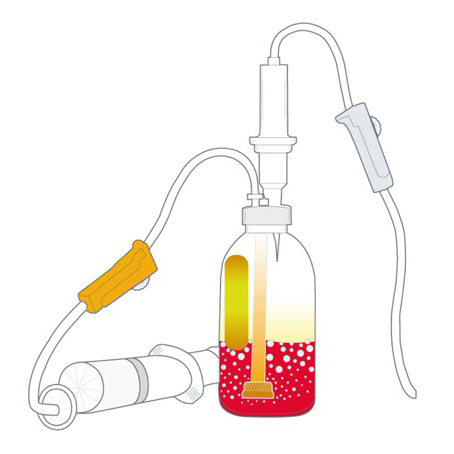
Major autohemotherapy MAH as extracoporeal blood treatment has become the most important form of low risk systemic ozone therapy:
under strict aseptic conditions, 50-100 ml venous blood are withdrawn from the patient into a vacuum flask with sodium citrate as anticoagulant, where the medical ozone/oxygen gas mixture is added to it - extracorporeally in a closed, sterile system - before being re-infused via drip infusion (pressure-free). The ozone/oxygen mixture passes through the patient's blood evenly, using the micro bubble system to produce a reaction surface as large as possible
in the short reaction time (less than 1 second). Thus contact with ozone can take place with nearly
all RBC´sand nearly all WBC´s making the ozone reaction as effective as possible, while the oxygen bubbles through, forming a layer of O2 gas above the liquid level in the flask.
Dosage range
Ozone dosage covers a range between 500 µg and max. 4000 µg ozone per treatment, using a quantity of blood between 50 and 100 ml.
all RBC´sand nearly all WBC´s making the ozone reaction as effective as possible, while the oxygen bubbles through, forming a layer of O2 gas above the liquid level in the flask.
Dosage range
Ozone dosage covers a range between 500 µg and max. 4000 µg ozone per treatment, using a quantity of blood between 50 and 100 ml.
Main Indications
Angiopathies, arterial circulatory disturbances, chronic inflammatory diseases and chronic hepatitis.
Contraindications
Glucose-6-phosphate-dehydrogenase deficiency (favism, acute hemolytic anemia) Hyperthyroidism (if not controlled) The first 3 months of pregnancy Major autohemotherapy is not indicated in leukemia.
Angiopathies, arterial circulatory disturbances, chronic inflammatory diseases and chronic hepatitis.
Contraindications
Glucose-6-phosphate-dehydrogenase deficiency (favism, acute hemolytic anemia) Hyperthyroidism (if not controlled) The first 3 months of pregnancy Major autohemotherapy is not indicated in leukemia.
This is one of the earliest forms of application in ozone therapy (Aubourg 1936). Based on animal investigations and a comprehensive proctological
study (Knoch 1987), rectal insufflation with an O3/O2 gas mixture is increasingly being used as a systemic therapeutic form, and is already being
viewed as an alternative to MAH; it is the method of choice in pedriatrics.
Method
A rectal insufflation set consists of: An ozone supply container with lock valve, dosing bag with non-return valves, connecting tube with luer/luer lock or 50 ml silicone-coated disposable syringe, and rectal catheter.
Indications
Local: Ulcerous colitis, proctitis, stages I and II, anal fistulae and fissures.
Systemic: Indications cited for MAH, hepatitis B and C,
for immunomodulation (complementary method in oncology)
Dosage
Systemic: 10-25 µg ozone/ml oxygen gas mixture,
Method
A rectal insufflation set consists of: An ozone supply container with lock valve, dosing bag with non-return valves, connecting tube with luer/luer lock or 50 ml silicone-coated disposable syringe, and rectal catheter.
Indications
Local: Ulcerous colitis, proctitis, stages I and II, anal fistulae and fissures.
Systemic: Indications cited for MAH, hepatitis B and C,
for immunomodulation (complementary method in oncology)
Dosage
Systemic: 10-25 µg ozone/ml oxygen gas mixture,
volume 150-300 ml;
for children: 10-20 µg/ml, volume 10-30 ml
Local: in ulcerous colitis, high O3/O2 concentrations (70-80-100 µg/ml) and small volumes (50 ml) are applied; on cessation of hemorrhage, this is reduced to 30-20 µg/ml, followed by systemic efficacy: 10-20 µg/ml, 150-300 ml volume.
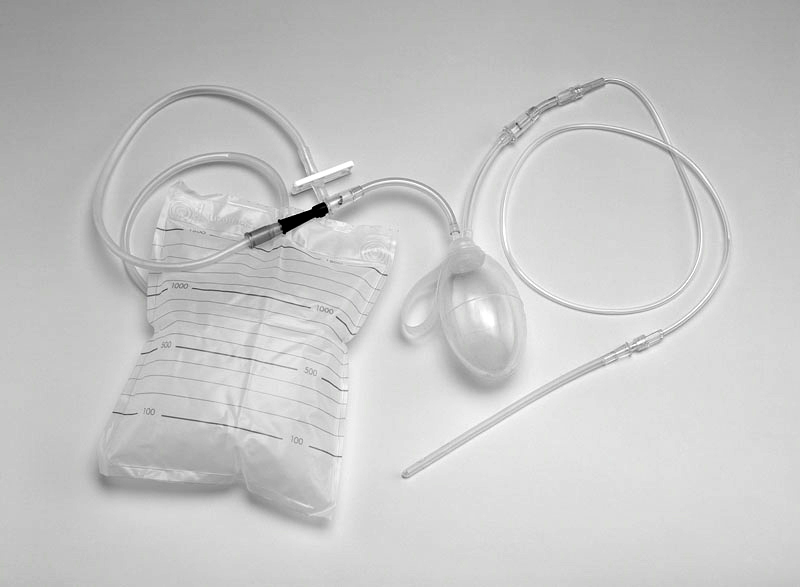
Local: in ulcerous colitis, high O3/O2 concentrations (70-80-100 µg/ml) and small volumes (50 ml) are applied; on cessation of hemorrhage, this is reduced to 30-20 µg/ml, followed by systemic efficacy: 10-20 µg/ml, 150-300 ml volume.

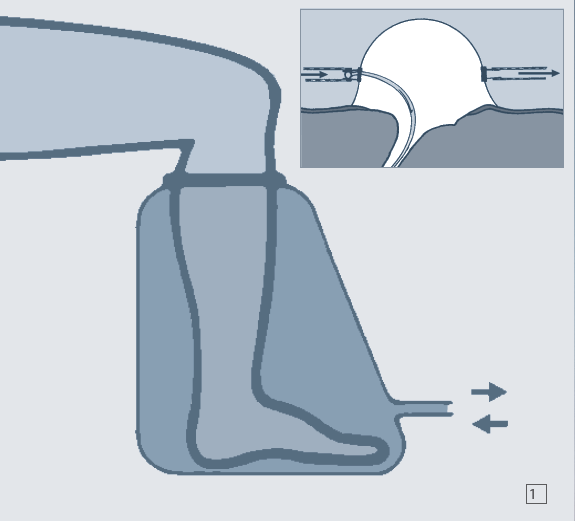
Transcutaneous "ozone gas immersion" is a method of choice in extensive, deep topical infections. Here, after moistening the extremity to
be treated or the area over the organ concerned, direct O3 gas immersion is applied inside a sealed, ozone-resistant plastic bag, or in a slight
vacuum using a special, low-pressure "boot" or under a low-pressure cup.
Indications
Skin lesions, burns, superinfected wounds (surgical scars), diabetic foot, phlegmons (erysipela),
Indications
Skin lesions, burns, superinfected wounds (surgical scars), diabetic foot, phlegmons (erysipela),
large-surface, open and deep chronic ulcers,
possibly infected, and decubitus ulcers.
Method and concentrations
In transcutaneous ozone gas immersions or low-pressure applications used in the treatment of
Method and concentrations
In transcutaneous ozone gas immersions or low-pressure applications used in the treatment of
infected ulcers,
the O3/O2 mixture is
initially applied at higher concentrations (70-100 µg/ml) after moistening of the area
to be treated. Its microbicidal and virostatic
effect already takes place at lower concentrations
(< 40 µg/ml). Once wound healing has actually started, the concentration can again be reduced (< 20 µg/ml).
(< 40 µg/ml). Once wound healing has actually started, the concentration can again be reduced (< 20 µg/ml).
continue reading... Injections / Ozone water / Ozone cream
Minor autohemotherapy with ozone
As a non-specific, immune stimulant therapy, comparable to an “autovaccination”, not only ozone-specific.
Indications
Acne vulgaris (common acne), allergies, adjuvant in cancer therapy, unspecific immunoactivation
Method
In minor autohemotherapy (MinAH), under aspetic conditions, 2-5 ml blood is removed intravenously and drawn into a sterile, pyrogen-free 30 ml disposable syringe (already containing the ozone-oxygen mixture), where it is mixed with 10 ml of an O3/O2 gas mixture, intensively shaken and slowly reinjected intramuscularly in the ventrogluteal region. Ozone concentration: 10-20 µg/ml.
Minor autohemotherapy with ozone
As a non-specific, immune stimulant therapy, comparable to an “autovaccination”, not only ozone-specific.
Indications
Acne vulgaris (common acne), allergies, adjuvant in cancer therapy, unspecific immunoactivation
Method
In minor autohemotherapy (MinAH), under aspetic conditions, 2-5 ml blood is removed intravenously and drawn into a sterile, pyrogen-free 30 ml disposable syringe (already containing the ozone-oxygen mixture), where it is mixed with 10 ml of an O3/O2 gas mixture, intensively shaken and slowly reinjected intramuscularly in the ventrogluteal region. Ozone concentration: 10-20 µg/ml.
Subcutaneous and intracutaneous application
Indications
As a non-specific, immune stimulant therapy, comparable to an “autovaccination”, not only ozone-specific.
Indications
Acne vulgaris (common acne), allergies, adjuvant in cancer therapy, unspecific immunoactivation
Method
In minor autohemotherapy (MinAH), under aspetic conditions, 2-5 ml blood is removed intravenously and drawn into a sterile, pyrogen-free 30 ml disposable syringe (already containing the ozone-oxygen mixture), where it is mixed with 10 ml of an O3/O2 gas mixture, intensively shaken and slowly reinjected intramuscularly in the ventrogluteal region. Ozone concentration: 10-20 µg/ml.
Minor autohemotherapy with ozone
As a non-specific, immune stimulant therapy, comparable to an “autovaccination”, not only ozone-specific.
Indications
Acne vulgaris (common acne), allergies, adjuvant in cancer therapy, unspecific immunoactivation
Method
In minor autohemotherapy (MinAH), under aspetic conditions, 2-5 ml blood is removed intravenously and drawn into a sterile, pyrogen-free 30 ml disposable syringe (already containing the ozone-oxygen mixture), where it is mixed with 10 ml of an O3/O2 gas mixture, intensively shaken and slowly reinjected intramuscularly in the ventrogluteal region. Ozone concentration: 10-20 µg/ml.
Subcutaneous and intracutaneous application
Indications
Pain management, trigger points, acupuncture points herpes zoster, trigger points in combination with local anesthetics (neural therapy), tonanalgetic systems
with local anesthetics (neural therapy), tonanalgetic systems
Concentrations
2-5 without local anesthetic, 10-15 µg/ml with local anesthesia.
Intradiscal injections
Intradiscal injections in herniated discs may only be performed when monitored by imaging systems as found in hospital departments where these are available.
Intraarticular ozone injections
Intraarticular ozone injections in acute and chronic, painful joint conditions represents a complementary treatment method providing rapid pain relief, decongestion, a reduction in inflammation and an improvement in motility. It involves mainly knee and shoulder joints presenting chronic pathological symptoms.
Indications
Symptoms of the rheumatic and degenerative type, diseases and injuries of the joints (arthrosis, arthropathias) Active gonarthrosis, acute diseases of the shoulder joints involving partially restricted functional movement (shoulder stiffness) Chronic shoulder joint conditions with calcification and painfully restricted movements in the final stage.
Method
Intraarticular injection of an ozone/oxygen gas mixture must be considered as being an intervention in a sterile system (joint), to be carried out under specially strict aseptic precautionary measures, see special guidelines for intraarticular injections.
with local anesthetics (neural therapy), tonanalgetic systems
Concentrations
2-5 without local anesthetic, 10-15 µg/ml with local anesthesia.
Intradiscal injections
Intradiscal injections in herniated discs may only be performed when monitored by imaging systems as found in hospital departments where these are available.
Intraarticular ozone injections
Intraarticular ozone injections in acute and chronic, painful joint conditions represents a complementary treatment method providing rapid pain relief, decongestion, a reduction in inflammation and an improvement in motility. It involves mainly knee and shoulder joints presenting chronic pathological symptoms.
Indications
Symptoms of the rheumatic and degenerative type, diseases and injuries of the joints (arthrosis, arthropathias) Active gonarthrosis, acute diseases of the shoulder joints involving partially restricted functional movement (shoulder stiffness) Chronic shoulder joint conditions with calcification and painfully restricted movements in the final stage.
Method
Intraarticular injection of an ozone/oxygen gas mixture must be considered as being an intervention in a sterile system (joint), to be carried out under specially strict aseptic precautionary measures, see special guidelines for intraarticular injections.
In topical applications, the use of ozonized water is now gaining in importance. Ozone is present in water in molecular form, i.e. as O3,
presenting a physical solution. When using bidistilled water (aqua bidestillata) and a high-quality ozone generator, a maximum saturation of
approx. 20 µg ozone per ml of water at room temperature can be obtained. It reacts immediately on skin contact, contrary to ozonides, such as e.g.
ozone cream, which have a long-term effect.
Indications
Local infections, ulcus cruris, decubitus ulcers, mycosis, mycotic infections, herpes simplex and herpes zoster (also including subcutaneous ozone injections where required), burns, also superinfected burns, intraoperative rinsing, eye injuries and infections,surgical scars (healing: primary or secondary), edemas of traumatic or bacterial origin.
Method and concentration
For 5-10 minutes, allow an ozone/oxygen gas mixture at an O3 concentration > 100 (4 min in Ozonosan alpha plus) or 60-80 µg/ml
Indications
Local infections, ulcus cruris, decubitus ulcers, mycosis, mycotic infections, herpes simplex and herpes zoster (also including subcutaneous ozone injections where required), burns, also superinfected burns, intraoperative rinsing, eye injuries and infections,surgical scars (healing: primary or secondary), edemas of traumatic or bacterial origin.
Method and concentration
For 5-10 minutes, allow an ozone/oxygen gas mixture at an O3 concentration > 100 (4 min in Ozonosan alpha plus) or 60-80 µg/ml
(10 min with Ozonosan
photonik) to pass in the form of small bubbles through 1 litre aqua bidestillata with a water column of approx. 40 cm. In bidistilled water,
the half life of ozone is approx. 10 hrs at room temperature, the concentration remaining approx. 18-24 µg/ml at 20 °C [68 °F]. In the refrigerator,
ozonized bidistilled water can be kept for several days.
Overdosage is not possible, as the dose is limited by the solubility of ozone in water, approx. 24 µg/ml for aqua bidestillata. Ozonized water is basically applied on account of its pain-relieving, disinfectant and antiinflammatory effects, as well as its tissue-activating properties in acute and chronic injuries with and without infection. In these indications, it is being applied with increasing success. Here, especially, the elimination of perifocal edema is in the foreground. Ozonized water is also being used intraoperatively for rinsing (disinfection), as in hand surgery, in dental medicine and particularly in oral surgery. The healing time for primary scars is shortened and irritation-free. In a number of cases, long-term treatment can be continued using peroxidic oils.
Overdosage is not possible, as the dose is limited by the solubility of ozone in water, approx. 24 µg/ml for aqua bidestillata. Ozonized water is basically applied on account of its pain-relieving, disinfectant and antiinflammatory effects, as well as its tissue-activating properties in acute and chronic injuries with and without infection. In these indications, it is being applied with increasing success. Here, especially, the elimination of perifocal edema is in the foreground. Ozonized water is also being used intraoperatively for rinsing (disinfection), as in hand surgery, in dental medicine and particularly in oral surgery. The healing time for primary scars is shortened and irritation-free. In a number of cases, long-term treatment can be continued using peroxidic oils.
(Ozonides and peroxides)
As reaction products of O3 and unsaturated fatty acids, ozone peroxides and ozonides, trioxolane also stimulate the cell metabolism. An improvement of wound disinfection and wound healing could be clearly demonstrated for burns and
As reaction products of O3 and unsaturated fatty acids, ozone peroxides and ozonides, trioxolane also stimulate the cell metabolism. An improvement of wound disinfection and wound healing could be clearly demonstrated for burns and
mechanical injuries in an animal study.
In combination with rectal insufflation it is suited as a lubricant.
As a cosmetic it is used for problematic skin, as well as for stimulation of cell metabolism for revitalization and regeneration of the skin (anti aging effect).
As an initially gaseous medical substance, special forms of application are obviously necessary for an ozone/oxygen mixture. As, due to its very bad solvency in aqueous media, oxygen has a secondary embolizing effect; therefore, in spite of all the pros and cons, the intravasal administration of an ozone/oxygen mixture is nevertheless to be viewed as a contraapplication.
Contrasted with the almost instant chemical reaction of O3 in whole blood, oxygen remains in its molecular form as a physical solution. It is from this aspect that extracorporeal treatment has been developed in place of intravasal administration. Intravenous and intraarterial gas injections ought to be abandoned in favor of major autohemotherapy.
Continue reading...
| Contraindications | Contraapplications |
| Hyperthyreosis if not controlled |
Direct gas injections: intravenous injections strictly prohibited, intraarterial not recommended |
| Favism, Glucose-6-phosphate-dehydrogenase deficiency in RBCs |
Hyperbaric ozone auto-hemotherapy infusions
|
|
The first 3 months of pregnancy Acute hemolytic anemia Major autohemotherapy is not indicated in leukemia |
Ozonized infusion solutions if not carefully tested
|
Pharmacology
Chronic inflammatory diseases or processes accompanied by chronic inflammation are indications for systemically
administered ozone in the form of major autohemotherapy MAH and rectal insufflation RI:
- Angiopathia
- Arterial circulatory disturbances
- Chronic inflammatory rheumatic disease
- Chronic intestinal conditions
- Virus-conditioned diseases
- Immune deficiency
- Complementary oncology
- Arterial circulatory disturbances
- Chronic inflammatory rheumatic disease
- Chronic intestinal conditions
- Virus-conditioned diseases
- Immune deficiency
- Complementary oncology
All the indications have one phenomenon in common: high oxidative stress, reactive oxygen species, such as radical and non radical oxidants, a
suppressed antioxidant capacity and immunologic disbalance, each of which in turn promotes and maintains the inflammatory process: pathologically
increased values for malone dialdehyde MDA, hydrogen peroxide H2O2, total hydroperoxide TH, nitrogen monoxide NO and an antioxidant deficit,
disbalanced superoxide dismutase and subgroups of SOD as well as catalase CAT …..and reduced glutathion GSH as a consequence.
The pharmacological effects of the Low-Dose Ozone Concept are well known, documented and published; the three basic pharmacological
effects are:
- Activation of the Red Blood Cell metabolism with an improvement of oxygen release and availability
- Activation of immunocompetent cells with a regulation of the immune response resulting in an immunomodulation
- Regulation of the enzymatic antioxidants and improvement of the antioxidant capacity cells and organs, with a reduction of oxidative
stress as a consequence.
The pharmacological effects oft he of the Low-Dose Ozone Concept are well known, documented and published;
the three basic pharmacological effects are:
- Activation of the Red Blood Cell metabolism with an improvement of oxygen release and availability
- Activation of immunocompetent cells with
- Activation of the Red Blood Cell metabolism with an improvement of oxygen release and availability
- Activation of immunocompetent cells with
a regulation of the immune response resulting in an immunomodulation
- Regulation of the enzymatic antioxidants and improvement of the antioxidant capacity cells and organs, with a reduction of oxidative stress as a consequence.
- Regulation of the enzymatic antioxidants and improvement of the antioxidant capacity cells and organs, with a reduction of oxidative stress as a consequence.
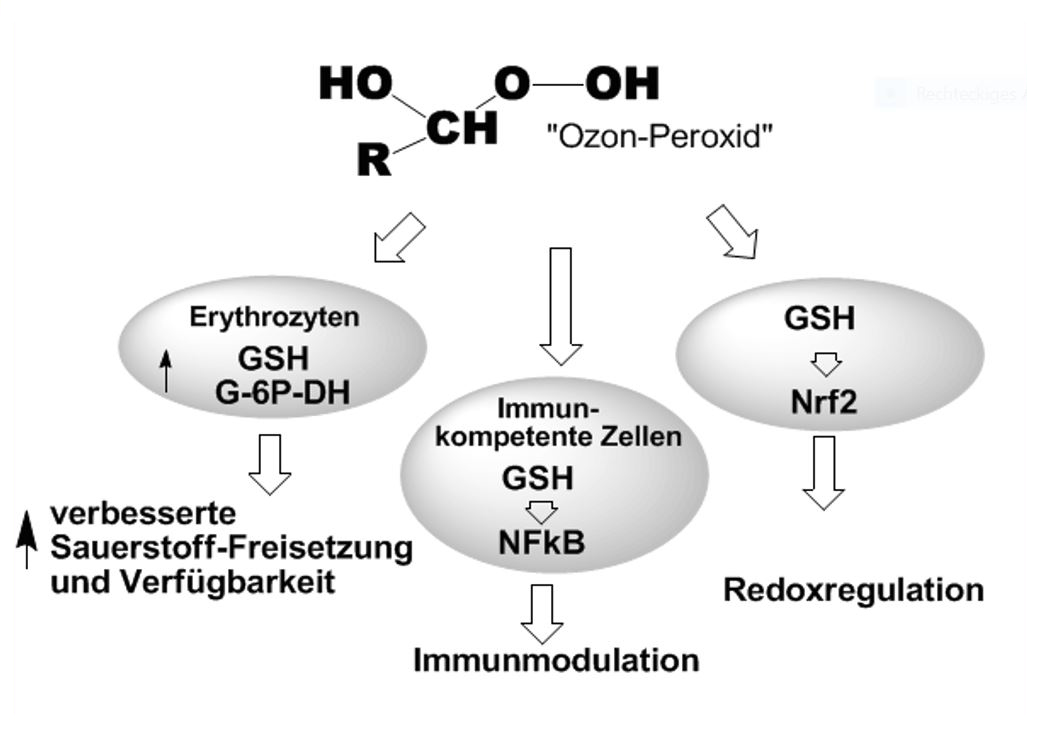
Chronic inflammatory diseases or processes accompanied by chronic inflammation are indications for systemically administered
ozone in the form of major autohemotherapy MAH and rectal insufflation RI:
- Angiopathia
- Arterial circulatory disturbances
- Chronic inflammatory rheumatic disease
- Chronic intestinal conditions
- Virus-conditioned diseases
- Immune deficiency
- Complementary oncology
- Angiopathia
- Arterial circulatory disturbances
- Chronic inflammatory rheumatic disease
- Chronic intestinal conditions
- Virus-conditioned diseases
- Immune deficiency
- Complementary oncology
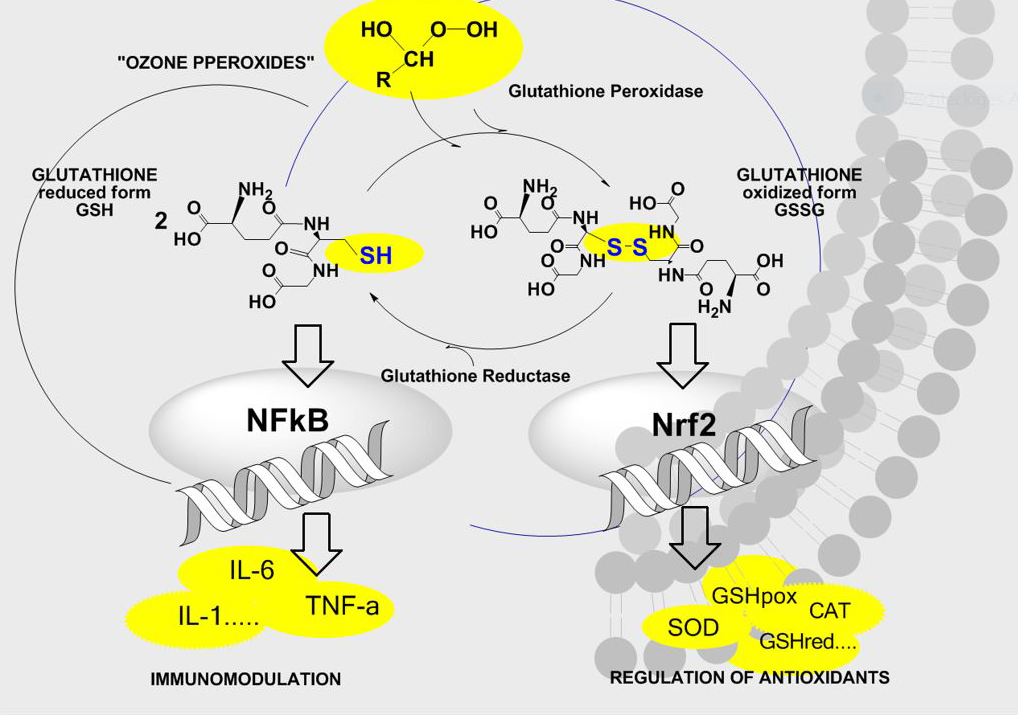
Systemic ozone therapy in the form of MAH or RI acts at low doses as bioregulator in chronic inflammatory conditions: the enzymatic antioxidants are upregulated, oxidative stress decresses. The short-chain „ozone peroxide“ with its low tendency to radical reactions could initiate the regulation of antioxidant protective mechanisms as redox signal e.g. via the nuclear factors NFkB and Nrf2 in stress and inflammation processes (Viebahn 2006; Gough 2009; León 1998).
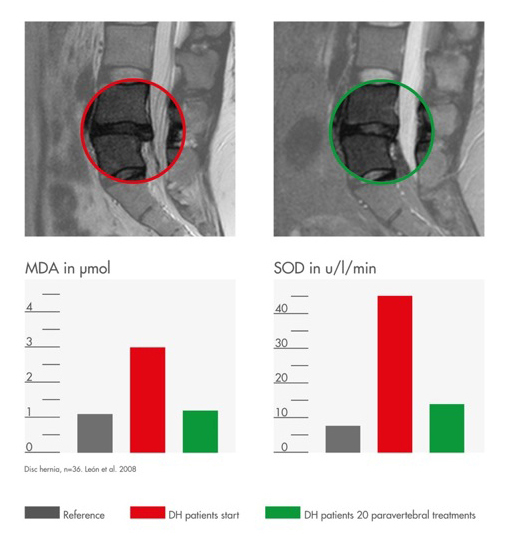
High oxidative stress in an acute inflammatory process, here in a case of herniated disc.
Low-dose ozone regulates the antioxidant status, in this case by downregulation of SOD as an example and compensation of oxidative stress, here MDA (Lehnert et al. 2006; León et al. 2012); see publication list under “Literature Service”
Low-dose ozone regulates the antioxidant status, in this case by downregulation of SOD as an example and compensation of oxidative stress, here MDA (Lehnert et al. 2006; León et al. 2012); see publication list under “Literature Service”
Ozone-Peroxides as Second Messenger molecules
The following Figure gives a schematic survey of the bioregulation of antioxidants and cytokines through „ozone peroxide“ which is directly reduced
by glutathione GSH, the key reaction inducing the regulation. In healthy cells and organs the reaction H2O2 + GSH performs the task of signal
transduction to the nucleus via the nuclear factors, finally activating or inactivating special DNA segments for the production of the cell specific proteins. In chronic oxidative stress diseases this information
and regulation is completely disturbed in spite of a huge content of H2O2 and the „ozone peroxide“ adopts this function.
The central oxidation of GSH to GSSG (reduced glutathione to the oxidized form) emerges as the ozone concentration and „ozone peroxide“ dose limiting factor:
2 GSH ⇄ GSSG (≃ 90 % GSH : 10% GSSG in a healthy cell metabolism); this balance must not be disturbed in any case, i.e. the reduced form GSH should never drop during a systemic ozone treatment series.
Information for patients
Contact
Medical Society for the Use of Ozone in
Prevention and Therapy
(Ärztliche Gesellschaft für Ozonanwendung in
Prävention und Therapie e.V.)
Registered: Amtsgericht Frankfurt am Main,
Germany, VR 6324
President
Dr. med Wilhelm Schüler
schueler@dr-schueler.com
Prevention and Therapy
(Ärztliche Gesellschaft für Ozonanwendung in
Prävention und Therapie e.V.)
Registered: Amtsgericht Frankfurt am Main,
Germany, VR 6324
President
Dr. med Wilhelm Schüler
schueler@dr-schueler.com
Office: Iffezheim / Baden-Baden
Dr. Renate Viebahn-Hänsler
Nordring 10
D-76473 Iffezheim
renate.viebahn@ozongesellschaft.de
renate.viebahn@ozone-association.com
info@ozongesellschaft.de (Office)
www.ozongesellschaft.de
Dr. Renate Viebahn-Hänsler
Nordring 10
D-76473 Iffezheim
renate.viebahn@ozongesellschaft.de
renate.viebahn@ozone-association.com
info@ozongesellschaft.de (Office)
www.ozongesellschaft.de

European Ozone Congress, Charité Berlin, 2017
Impressum
Editor
Medical Society for the Use of Ozone in Prevention and Therapy
(Ärztliche Gesellschaft für Ozonanwendung in Prävention und Therapie e.V.)
Registered: Amtsgericht Frankfurt am Main, Germany, VR 6324
Photos: Privat
Medical Society for the Use of Ozone in Prevention and Therapy
(Ärztliche Gesellschaft für Ozonanwendung in Prävention und Therapie e.V.)
Registered: Amtsgericht Frankfurt am Main, Germany, VR 6324
Photos: Privat
Responsible for the content
Dr. Renate Viebahn-Hänsler
Nordring 10
D-76473 Iffezheim
renate.viebahn@ozongesellschaft.de
Dr. Renate Viebahn-Hänsler
Nordring 10
D-76473 Iffezheim
renate.viebahn@ozongesellschaft.de
Legal Statement
Legal Statement
Information and data
„Medical Society for the Use of Ozone in Prevention and Therapy“ undertakes to ensure to the best of their ability that the information and data on this website are appropriate and accurate. This nevertheless excludes us assuming any liability or warranty concerning the modernity, correctness or completeness of the information and data provided. We reserve the right to make changes and/or amendments in the presented information and data without previous notification.
Data protection / privacy
Your personal data are subject to the European General Data Protection Regulation (GDPR) (EU) 2018. You may possibly be asked to provide us with personal information, for example when sending e-mails. The answering of questions or the communication of name, address or phone number etc. is voluntary. All data obtained in this way will exclusively be used for invitations to our training and development activities. Data of members of the society are not publishe on this website.
Copyright
© „Medical Society for the Use of Ozone in Prevention and Therapy“ (Deutschland / Germany); the spciety reserves all rights. Text, images, graphic representations, sound, animations and video sequences. The entire content of the Website is protected by copyright. Hence, any reproduction of information or data — especially the use of texts, text excerpts, graphics and other images from the website — is subject to the explicit prior consent of the „Medical Society for the Use of Ozone in Prevention and Therapy“ in acceptable and written form. We hereby draw express attention to the fact that some of the images on the websites may be — completely or in part — subject to the copyright of a third party.
Data protection / privacy
Your personal data are subject to the European General Data Protection Regulation (GDPR) (EU) 2018. You may possibly be asked to provide us with personal information, for example when sending e-mails. The answering of questions or the communication of name, address or phone number etc. is voluntary. All data obtained in this way will exclusively be used for invitations to our training and development activities. Data of members of the society are not publishe on this website.
Copyright
© „Medical Society for the Use of Ozone in Prevention and Therapy“ (Deutschland / Germany); the spciety reserves all rights. Text, images, graphic representations, sound, animations and video sequences. The entire content of the Website is protected by copyright. Hence, any reproduction of information or data — especially the use of texts, text excerpts, graphics and other images from the website — is subject to the explicit prior consent of the „Medical Society for the Use of Ozone in Prevention and Therapy“ in acceptable and written form. We hereby draw express attention to the fact that some of the images on the websites may be — completely or in part — subject to the copyright of a third party.
Links
The „Medical Society for the Use of Ozone in Prevention and Therapy“ is not responsible for the content of websites referred to via hyperlinks, and thus also not responsible in any way for contents obtained through using such a link.
Liability
This website was created with the greatest possible care; nevertheless, The „Medical Society for the Use of Ozone in Prevention and Therapy“ cannot assume any legal responsibility as to the accuracy, precision and completeness of the information contained therein, and therefore excludes any responsibility for damages caused directly or indirectly by the use of this website, insofar as these are not attributable to intent or gross negligence.
License / rights of use
It is the aim of the „Medical Society for the Use of Ozone in Prevention and Therapy“ to present you with an innovative and informative website. The intellectual property contained in it, are protected. The publication of this website confers no license to any third party for the use of this intellectual property.
Legal rights
All and any information or data, the use there of and in particular any infringement against secrecy of content matter available via password to authorized users only in a protected area of the website, including every action, tolerance or omission, are exclusively subject to German Law.
The „Medical Society for the Use of Ozone in Prevention and Therapy“ is not responsible for the content of websites referred to via hyperlinks, and thus also not responsible in any way for contents obtained through using such a link.
Liability
This website was created with the greatest possible care; nevertheless, The „Medical Society for the Use of Ozone in Prevention and Therapy“ cannot assume any legal responsibility as to the accuracy, precision and completeness of the information contained therein, and therefore excludes any responsibility for damages caused directly or indirectly by the use of this website, insofar as these are not attributable to intent or gross negligence.
License / rights of use
It is the aim of the „Medical Society for the Use of Ozone in Prevention and Therapy“ to present you with an innovative and informative website. The intellectual property contained in it, are protected. The publication of this website confers no license to any third party for the use of this intellectual property.
Legal rights
All and any information or data, the use there of and in particular any infringement against secrecy of content matter available via password to authorized users only in a protected area of the website, including every action, tolerance or omission, are exclusively subject to German Law.
25.09.25